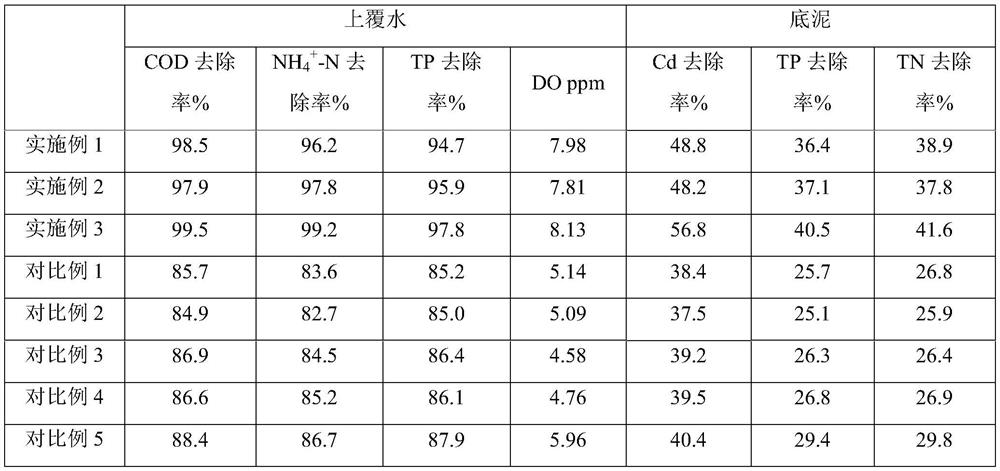Small Watershed River Restoration Method
A technology for river restoration and small watersheds, which is applied in the field of river pollution control, can solve problems such as unsuitable for large-scale promotion and application, poor purification effect, and large labor load, and achieve the effects of improving water quality, good purification effect, and reducing treatment costs
- Summary
- Abstract
- Description
- Claims
- Application Information
AI Technical Summary
Problems solved by technology
Method used
Image
Examples
Embodiment 1
[0045] A small watershed river restoration method, comprising the following steps:
[0046] S1. Salvage the solid waste deposited in the river, and remove the non-degradable debris in the bottom mud of the river;
[0047] S2, put into the river channel the adsorption microspheres with a particle size of 20cm, after stirring for 2 hours, let stand for 24 hours to remove the adsorption microspheres;
[0048] The adsorption microspheres are composed of citric acid, pullulan and zeolite with a mass ratio of 6:1:12; the added amount of the citric acid is 0.06% of the weight of the river bottom mud;
[0049] S3, throwing modified clay and composite strains in the river;
[0050]The modified clay is composed of calcium nitrate, clay and chitosan with a mass ratio of 1:100:2; the added amount of the modified clay is 0.05% by weight of river water body;
[0051] The composite bacterial species is composed of Bacillus subtilis, yeast, nitrifying bacteria and ammonia oxidizing bacteria...
Embodiment 2
[0054] A small watershed river restoration method, comprising the following steps:
[0055] S1. Salvage the solid waste deposited in the river, and remove the non-degradable debris in the bottom mud of the river;
[0056] S2, throwing into the river channel the adsorption microspheres with a particle size of 15 cm, after stirring for 3 hours, let stand for 36 hours to remove the adsorption microspheres;
[0057] The adsorption microspheres are composed of citric acid, pullulan and zeolite with a mass ratio of 6:1:12; the added amount of the citric acid is 0.02% of the weight of the river bottom mud;
[0058] S3, throwing modified clay and composite strains in the river;
[0059] The modified clay is composed of calcium nitrate, clay and chitosan with a mass ratio of 1:100:2; the added amount of the modified clay is 0.1% by weight of river water body;
[0060] The composite bacterial species is composed of Bacillus subtilis, yeast, nitrifying bacteria and ammonia oxidizing ba...
Embodiment 3
[0063] A small watershed river restoration method, comprising the following steps:
[0064] S1. Salvage the solid waste deposited in the river, and remove the non-degradable debris in the bottom mud of the river;
[0065] S2, throwing into the river channel the adsorption microspheres with a particle size of 18 cm, after stirring for 2.5 hours, let stand for 32 hours to remove the adsorption microspheres;
[0066] The adsorption microspheres are composed of citric acid, pullulan and zeolite with a mass ratio of 6:1:12; the added amount of the citric acid is 0.04% of the weight of the river bottom mud;
[0067] S3, throwing modified clay and composite strains in the river;
[0068] The modified clay is composed of calcium nitrate, clay and chitosan with a mass ratio of 1:100:2; the added amount of the modified clay is 0.08% by weight of the river water body;
[0069] The composite bacterial species is composed of Bacillus subtilis, yeast, nitrifying bacteria and ammonia oxidi...
PUM
| Property | Measurement | Unit |
|---|---|---|
| particle diameter | aaaaa | aaaaa |
Abstract
Description
Claims
Application Information
 Login to View More
Login to View More - R&D
- Intellectual Property
- Life Sciences
- Materials
- Tech Scout
- Unparalleled Data Quality
- Higher Quality Content
- 60% Fewer Hallucinations
Browse by: Latest US Patents, China's latest patents, Technical Efficacy Thesaurus, Application Domain, Technology Topic, Popular Technical Reports.
© 2025 PatSnap. All rights reserved.Legal|Privacy policy|Modern Slavery Act Transparency Statement|Sitemap|About US| Contact US: help@patsnap.com

